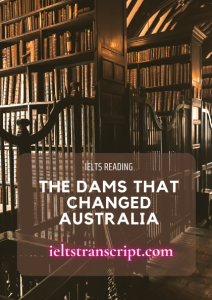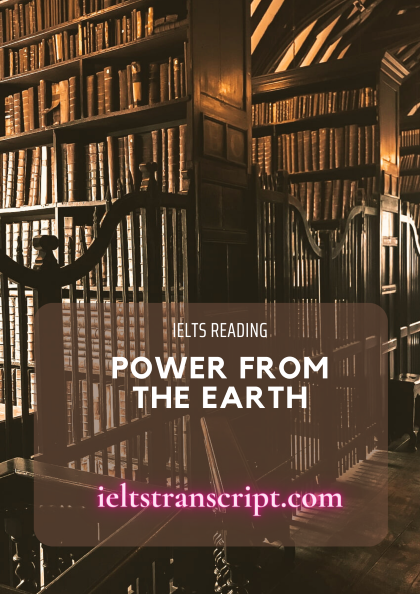- Đối với sản phẩm có giá: Sau khi chúng tôi ghi nhận thông tin đã thanh toán sản phẩm của bạn, sản phẩm sẽ được mở khóa và bạn có thể xem trực tiếp và tải tài liệu sản phẩm.
- Đối với thành viên trả phí: Bạn có thể mua và thanh toán sản phẩm với giá 0đ để tải tài liệu sản phẩm.
- Bạn có thể liên hệ với chúng tôi để được hỗ trợ mở khóa sản phẩm sớm nhất.
THE DAMS THAT CHANGED AUSTRALIA
THE DAMS THAT CHANGED AUSTRALIA
- Chúng tôi chấp nhận các phương thức thanh toán sau đây: Thẻ tín dụng, thẻ ghi nợ, PayPal, chuyển khoản ngân hàng và tiền mặt.
Chúng tôi sẽ không thu thêm phí cho bất kỳ hình thức thanh toán nào.
- Nếu bạn gặp vấn đề về sản phẩm của chúng tôi trong thời gian sử dụng, vui lòng liên hệ với chúng tôi để được hỗ trợ xử lý sớm nhất nhé.
Xem trước mẫu
THE DAMS THAT CHANGED AUSTRALIA
SECTION ONE
Inland Australia has had a problem with drought from the time of white settlement in 1788 until today, and this is why the Snowy Mountains Scheme was conceived and founded. Before the Snowy Scheme a large proportion of the snowfields on Australia’s highest mountains (the Snowy Mountains) melted into the Snowy River every year. Hence, Snowy River water flowed, ultimately, into the sea, not toward the dry interior of the country, where people needed it so desperately. This was first recognised by the Polish geologist and explorer Strezlecki in 1840, who commented that there could be no development of the inland without adequate water supply. The rivers would have to be diverted if irrigation were to succeed.
Before Federation in 1901, Australia consisted of a group of colonies, all anxious to protect their own interests. After Federation the states retained rights to the water, and thus to what might happen to the rivers. Arguments between New South Wales, Victoria and South Australia led to a deadlocked Premiers’ Conference in 1947. Despite this serious dispute, the Federal Parliament passed the Snowy Mountains Hydro-electric Power Act just two years later, on July 7. The project was officially commenced on October 17 that year, barely three months after the act had been passed.
The scheme set out to harness water for electricity and to divert it back to the dry inland areas for irrigation. To do this, thousands of kilometres of tunnels had to be drilled through the mountains, and sixteen major dams and seven hydro-electric power stations built over a period of nineteen years. The first of these was Guthega Power Station, which was commissioned in 1954. and the last one to be finished was Tumut III.
SECTION TWO
The Snowy Mountains Scheme was to alter the face of Australia forever. One important change was the recruitment of people from outside Australia to work on the scheme. In 1949, while the world was still recovering from the effects of World War II (1939 to 1945), the Australian government needed immense numbers of people to work on the Snowy. It sought labour from overseas, and 60,000 of the 100,000 people who worked on the scheme came from outside the country.
They came from thirty different countries: from Italy, Yugoslavia, and Germany, from sophisticated cities like Budapest, Paris and Vienna, and from tiny hamlets. These European workers left countries which had fought against each other during the war, and which had vastly different cultures, and they found themselves in a country which was still defining itself. They were adventurous young men, some highly skilled, some not, and they came to a place which offered both enormous challenges and primitive conditions. Many were housed in tents in the early days of the scheme, although some fortunate men were placed in barracks. The food was basic, female company extremely scarce and entertainment lacking.
SECTION THREE
Many new arrivals spoke only limited English, and were offered English classes after work. The men needed primarily to understand safety instructions, and safety lectures were conducted in English and other languages. In fact, a great deal of communication underground was by sign language, especially when the conditions were noisy. The signs were peculiar to the business at hand: for instance, a thumb placed near the mouth meant water, but did not indicate whether the water was needed on the drill the man was using, or for a drink.
The constant reference to the men who worked on the Snowy is appropriate because few women worked on the scheme, and those who were employed usually held office jobs. Women, however, were active in the community, and the members of the Country Women’s Association gave English lessons. Other English instruction was provided by the Australian Broadcasting Commission, which ran daily broadcasts to help the newcomers with the language.
SECTION FOUR
These circumstances could have caused
...NHỮNG CON ĐẬP ĐÃ THAY ĐỔI NƯỚC ÚC
Nội địa Úc đã gặp phải vấn đề hạn hán từ thời kỳ định cư của người da trắng vào năm 1788 cho đến tận ngày nay, và đây là lý do tại sao Đề án Snowy Mountains được hình thành và xây dựng. Trước khi có Đề án Snowy một phần lớn các cánh đồng tuyết trên các ngọn núi cao nhất của nước Úc (Snowy Mountains) đã tan chảy vào sông Snowy hàng năm. Do đó, cuối cùng, nước sông Snowy chảy ra biển chứ không phải hướng vào vùng nội địa khô cằn của đất nước, nơi mà mọi người vô cùng cần đến nó. Điều này được nhà địa chất và thám hiểm người Ba Lan Strezlecki nhận ra lần đầu tiên vào năm 1840, người đã nêu ra rằng vùng nội địa không thể phát triển nếu nó không được cung cấp đủ nước. Các con sông sẽ phải được chuyển hướng để việc tưới tiêu được thành công.
Trước khi Liên bang Úc được thành lập năm 1901, Úc bao gồm một nhóm các thuộc địa, tất cả đều lo lắng để bảo vệ lợi ích của chính họ. Sau khi Liên bang được thành lập, các bang vẫn duy trì các quyền đối với nước, và do đó họ có quyền đối với các con sông. Các cuộc tranh cãi giữa các bang New South Wales, Victoria và Nam Úc đã dẫn đến Hội nghị Thủ hiến bế tắc vào năm 1947. Bất chấp bất đồng nghiêm trọng này, Quốc hội Liên bang đã thông qua Đạo luật Năng lượng Thủy điện Snowy Mountains chỉ hai năm sau đó, vào ngày 7 tháng 7. Dự án chính thức được khởi công vào ngày 17 tháng 10 cùng năm, chỉ ba tháng sau khi đạo luật được thông qua.
Đề án đặt ra mục tiêu khai thác nước để lấy điện và chuyển nước trở lại các khu vực nội đồng khô hạn để tưới tiêu. Để làm được việc này, hàng nghìn km đường hầm phải được khoan xuyên qua các dãy núi, và mười sáu đập lớn và bảy nhà máy thủy điện được xây dựng trong khoảng thời gian mười chín năm. Công trình đầu tiên trong số này là Trạm điện Guthega, được đưa vào hoạt động năm 1954. và công trình cuối cùng được hoàn thiện là Tumut III.
PHẦN THỨ HAI
Đề án Snowy Mountains đã thay đổi bộ mặt của nước Úc mãi mãi. Một thay đổi quan trọng là việc tuyển dụng người ngoại quốc vào làm việc trong dự án này. Vào năm 1949, trong khi thế giới vẫn đang phục hồi sau ảnh hưởng của Thế chiến thứ II (1939-1945), chính phủ Úc cần một lượng lớn người làm việc trên dự án Snowy. Nước Úc đã tìm kiếm lao động từ các nước khác, và đã có 60.000 trong số 100.000 người làm việc trong dự án này đến từ nước ngoài.
Nguồn nhân lực nước ngoài đến từ ba mươi quốc gia khác nhau: từ Ý, Nam Tư và Đức, từ các thành phố phát triển như Budapest, Paris và Vienna cho đến những ngôi làng nhỏ bé. Những công nhân châu Âu này đã rời khỏi các quốc gia đã từng chiến đấu chống lại nhau trong chiến tranh, có nền văn hóa vô cùng khác biệt, và họ đã tìm thấy họ ở một đất nước vẫn đang trên con đường xác định mình. Họ là những chàng trai trẻ thích phiêu lưu, một số có kỹ năng cao, một số không, và họ đã đến một nơi có những thách thức to lớn và những điều kiện thô sơ. Nhiều người ở trong lều vào những ngày đầu của dự án, mặc dù một số người khác may mắn được ở trong doanh trại. Các bữa ăn đơn giản, đồng nghiệp nữ cực kỳ khan hiếm và thiếu phương tiện giải trí.
PHẦN BA
Nhiều người mới đến với tiếng Anh hạn chế và họ được tham gia các lớp tiếng Anh sau giờ làm việc. Những người đàn ông chủ yếu cần hiểu về các hướng dẫn an toàn và các bài giảng về an toàn được thực hiện bằng tiếng Anh và các ngôn ngữ khác. Trên thực tế, phần lớn giao tiếp dưới lòng đất là bằng các ký hiệu, đặc biệt là khi điều kiện làm việc có nhiều tiếng ồn. Các ký hiệu đặc biệt đối với công việc: ví dụ, ngón tay cái đặt gần miệng có nghĩa là nước, nhưng không chỉ rõ nước công nhân dùng để khoan hay để uống.
Cũng hợp lý khi liên tục đề cập đến những người đàn ông làm việc ở đề án Snowy vì có rất ít phụ nữ làm việc trong dự án này, và những người phụ nữ được tuyển dụng cũng thường làm công việc văn phòng. Tuy nhiên, phụ nữ hoạt động rất tích cực trong cộng đồng, chính các thành viên của Hiệp hội Phụ nữ Quốc gia đã dạy tiếng Anh. Các hướng dẫn tiếng Anh khác do Ủy ban Phát thanh Truyền hình Úc cung cấp, được phát
...Để xem được đầy đủ nội dung và tải dữ liệu, bạn phải trở thành thành viên của chúng tôi và trả phí cho tài liệu (nếu có)











